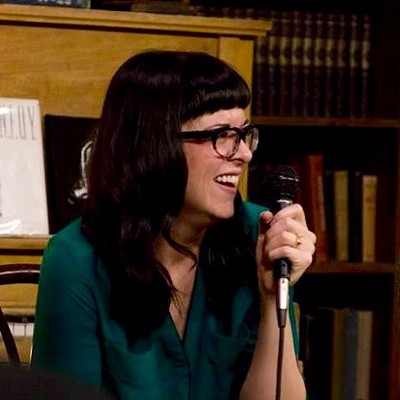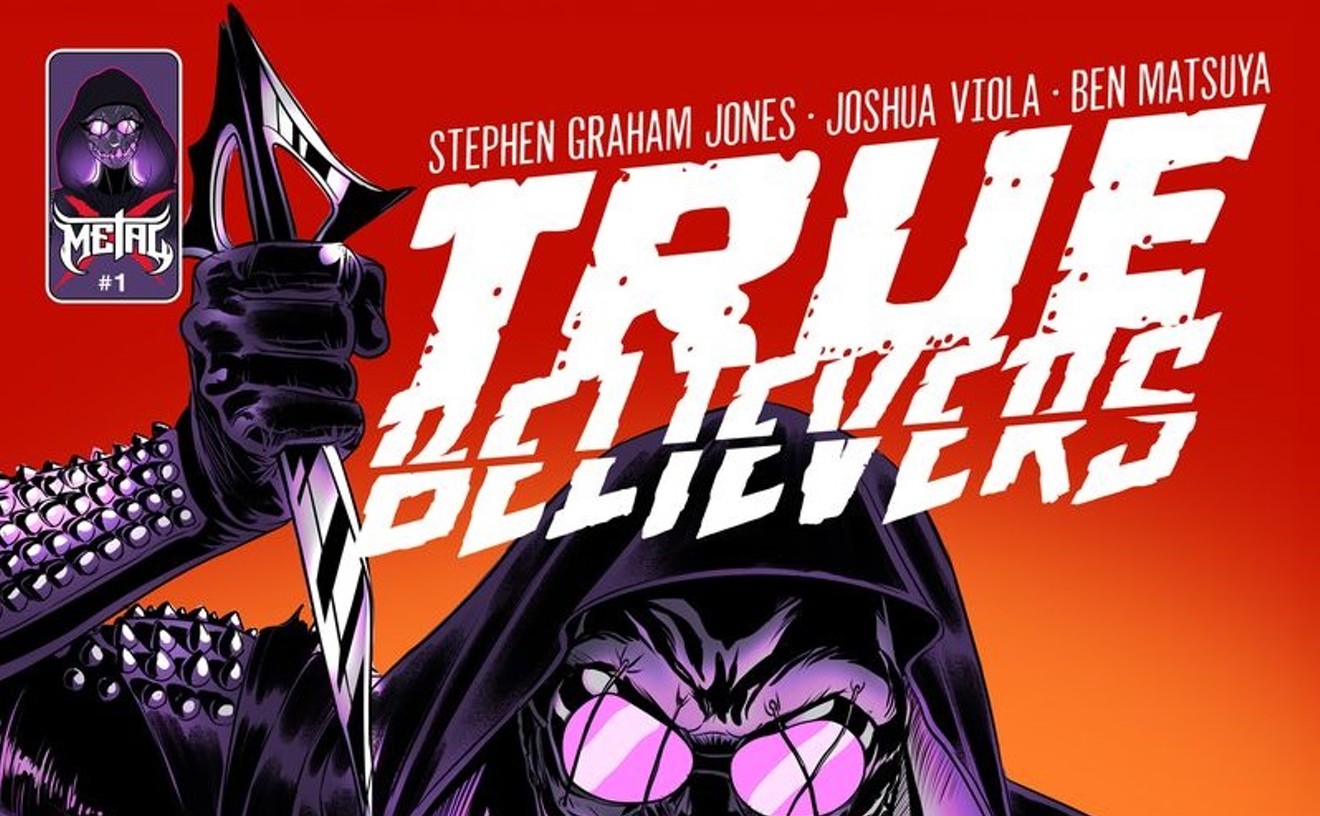Many of the photos, magazine clippings and postcards he shares are from his own collection; some are from his journeys through the archives at the Denver Public Library (which he is meticulous about crediting). Westword recently spoke with Lundin about his keen eye for Colorado-centric imagery, how he goes about sourcing the photographs and paper artifacts he displays, and what he's learned about Lakeside Amusement Park's not-so secret historical link to Freemasonry.
See also: Mary Voelz Chandler on Denver's demolition history and her updated architectural guide
Westword: Where do you get the photos that you share?Tom Lundin: Some are mine -- postcards and printed materials from Denver magazines. Sometimes I get them from the library too, and I will credit them. Sometimes I buy them off of eBay, stuff like that.
You post so many different kinds of images, from historic buildings that are long- gone to advertisements to renderings of mid-century modern structures that still exist today. Why and how do you choose what you post?
It's completely self-driven. My interest has grown over the years. I just started digging up microfiche at the library, originally looking up music history, and it just kept spreading. Then I started looking at nightclubs, then I started looking at restaurants, then I started looking at buildings and it kind of moved on from there.
I even have Alan Gass on there; he's a really fascinating guy. He's like a city-planning hero. He's been involved in so many projects -- he's done some buildings that are probably gone by now, but he's also done some great houses that are still around. He did a tour for Doors Open Denver -- it was a foot tour all over downtown where he covers I.M. Pei and things like that. When he was in New York as a college student, I think, he got to see the model for the Mile High Center and he got to go in there and work on some minor stuff. He was really young at the time.
Being on his good side is a great thing. (Laughs.) He's a busy man. One time, my wife and I got roped into doing a modernism tour for an organization and we went into the Temple Emanuel synagogue in Cherry Creek -- that is an amazing Usonian building. The guy that was our guide showed us around; he was just a nice, congenial old man. It was only after the tour that we found out it was Alan Gass. (Laughs.) That was the first time I met him.
Why did you decide to start the Denver Eye in the first place?I started out doing an illustration blog and started drawing modern buildings in 3D; then I started taking photos so I could have source material for the drawings. I started to like photography more because there is considerably less time involved than drawing. Then I moved over to doing the Denver Eye, because I was doing less illustration. I ended up doing a lot on the Denver Eye Facebook, just because it was a little bit faster (to post).
I don't know if you can tell, but there are typos in a lot of my posts (Laughs.) I just try to post and get the hell off of there because I have a job in Boulder that keeps me busy most of the time, so I'm not home all that often. If I am, I'd rather being illustrating or doing photography.
From a photographer's perspective, is there a type of architecture you're attracted to?
Obviously, '40s and '50s -- modern architecture. I like International style and I love Usonian architecture. There are plenty of structures still left in Denver -- maybe not commercial structures so much, but there are still a lot of houses left. My wife (Shannon Stanbro) is a midcentury modern architecture real estate agent; she has taken me in and out of a lot of them. They are amazing and I am just shocked at how many more there are hiding around. Denver is a mid-sized city, so there's a slower rate of destruction, then say, Los Angeles, where the same buildings would have been built over four or five times by now. Keep reading for more from Tom Lundin. I read a blog called Curbed LA and they have a section called "Time Capsules" where they showcase residential architectural marvels that end up on the market. The structures have usually had only one or two owners in their lifetime, and therefore retain most of the architectural details -- especially in the mid-century modern structures. Unfortunately, I think after these homes are sold, a lot of them get demolished.Right. Single-owner homes -- those are like the greatest to see. My wife brings me into see homes like that in Denver, especially if it's a good single-owner house, because they have everything intact. The kitchen is still intact, the bathrooms are still intact and often the flooring is still intact. It is really a sight to see.
But they will get destroyed. If someone buys one of these homes, they often immediately modernize it -- especially with kitchens -- and just destroy everything. But a lot of my wife's clients are interested in this kind of architecture, so they end up buying (a remodeled home) and restoring everything that someone else had just within the last six months has destroyed.
Like in Arapahoe Acres, I know a guy out there who offers to take or buy all of the fixtures that are taken out of those mid-century modern homes during renovations. Then when the house is back on the market, he goes back and tries to sell those pieces so it can be put back together. In that neighborhood, a lot of people aren't looking for a modern kitchen; they are looking for kitchen original to the house.
I'm in Boulder for work, and Boulder is kind of like California; they are ripping up everything they can. But they still have a ton of modern architecture and nobody knows it. I've seen most of it and it is fascinating. Charles Haertling is the architect of a lot of it.It is exciting that our state seems to be growing in population so fast, but it is hard not to be concerned that some buildings that should be saved will inevitably be demolished.
It gets really testy with these fights (over preservation) -- Michael Paglia and Diane Wray did some modern architecture history guides as well as an assessment of Boulder that is in the Carnegie Library up there where they assessed the entire city of Boulder for modern architecture, from Art Deco to late-modern. But only now are people starting to read it and pay attention -- though many of these buildings in Boulder have now been destroyed. These were the buildings that needed to be protected; they were the heritage of Boulder. There are still plenty of buildings left -- but it is easy to get disheartened.
It is hard because what is beautiful architecture to some is hideous to others.
There's a style, Brutalism, and people still hate that with a passion. I can get more controversy posting a photo of a Brutalist building than anything else. People that grew up in the '70s despise those buildings. But I think they are beautiful. There is a Charles Haertling Brutalist home on Shangri-La Drive in Denver and it is gorgeous, but a fence was put up around it recently and it blocks a lot of the view of it.
There are a few interesting structures on Shangri-La Drive which is sort of tucked away in Cherry Creek and I think a lot of people don't know about it. Harry Huffman (who built Shangri-La Drive) was a big guy in movie theaters -- he owned most of the theaters in Denver. His wife had seen Lost Horizon and wanted the same house as the one in the movie. Huffman had a better one built, I mean, compared to the one in the movie, the one in Denver looks better. Keep reading for more from Tom Lundin. Let's talk about Lakeside -- I get frustrated when people say it sucks or complain it's run-down. I don't think it sucks for a lot of reasons, but a big one for me is the architecture within the park -- it goes from turn-of-the-century to the mid-century additions like ticket booths by architect Richard Crowther.You know, he worked for Lakeside for something like twenty years. He just kept building stuff for them. He also did, somewhere in on the West Coast, maybe San Francisco or Los Angeles, I can't remember, some studying on neon lighting. So he was an expert on neon lighting, which you see all over the park. Aside from Lakeside, the homes he built later are ecologically sound (Crowther was at the forefront of passive solar energy in architecture) and really unique. There are some office buildings in Cherry Creek that people don't recognize are Crowther as well -- they all have weird protrusions from the roof where they can let in light at a certain time.
I didn't discover Crowther's "green" building history until I was reading up on Lakeside and came across your illustrated renderings of his ticket-booth designs for the park.
I'm not even proud of my Lakeside photos because I took them in, I think, 2006? I was just starting out in photography and I didn't take them to be good photos, I took them to have material to draw the booths. I didn't care about where the lighting was coming from or anything like that.
I've done a whole bunch of stuff on Lakeside -- it was one of the many "White Cities" they built around the United States after the Chicago World's Fair (also known as the Columbian Exposition in 1893; Lakeside opened in 1908.) Originally, it was all Beaux-Arts style with light bulbs all over the place.There's something else weird about Lakeside: it has a quasi-Masonic angle to it, too. Around the same time they were building it, they had a Knights Templar enclave in Denver. Denver was trying to bring in big meetings in -- they brought in the Democratic convention and things like that.
They brought in the Knights Templar, which was a degree in Masonic brotherhood. The same decorations they were using to decorate Denver with at the time -- and there are tons of photos of this on the Denver Public Library's site -- they used in Lakeside. The same kind of symbolism they put all over Lakeside -- they are all over the front (the original entrance) but have mostly been painted over so you can't see them. But there are iron crosses and Maltese crosses that used to be all colored and lit with light bulbs. Now they have been covered up.
But they used to have a ride at Lakeside, where the bumper cars are now, that was a fun house; the original fun house, not the famous fun house that everybody knows and was located where the Dragon is now. But anyway, that fun house was called "The Thirty-Third Degree," which is the Masonic term for the highest degree you can go. You can find a picture on the Denver Public Library's site of the fun house, and in front of the fun house are all of the Knights Templar Masons, because they were meeting there. So there is some connection.I think Lakeside was built by Zang (Adolph Zang, prominent Denver brewer and businessman), and I would guess he was a Mason. Plus, the Masons built a beautiful El Jebel Temple on 18th and Sherman (now known as the Sherman Events Center, built in 1907) and then built a contemporary Shrine near Lakeside, on the other side of Willis Case Golf Course. The El Jebel Events Center (built in 1928) became their home after they outgrew the Temple on 18th Street.
Lakeside's history is so deep, but I feel like it's not always seen for its rich historical value.
Everybody assumes a lot about it -- I hear things like, "Oh, if I had the money, I would put all of my money into Lakeside." I honestly don't think Lakeside is that hurting for money. They used to have a mall there in the '60s that had a lot of major stores in it and I'm guessing they get some income from the other buildings that are on the property. There's a bank on the property, there's a really cool Mexican restaurant on the other side of the lake.
See more on blog and The Denver Eye, Tom Lundin's Facebook page.
Be my voyeur (or better yet, let me stalk you) on Twitter: @cocodavies











